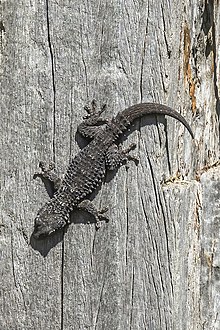Tarentola mauritanica
| Tarentola mauritanica | |
|---|---|

| |
| Scientific classification | |
| Domain: | Eukaryota |
| Kingdom: | Animalia |
| Phylum: | Chordata |
| Class: | Reptilia |
| Order: | Squamata |
| Family: | Phyllodactylidae |
| Genus: | Tarentola |
| Species: | T. mauritanica
|
| Binomial name | |
| Tarentola mauritanica | |

| |
Native range
Introduced range
| |
Tarentola mauritanica, known as the common wall gecko, is a species of
The species was first described by Carl Linnaeus in 1758.[3] It is also known as moorish gecko, crocodile gecko, European common gecko, and, regionally, as osga (in Portuguese), salamanquesa (in Spanish) and dragó (in Catalan).
Description
Adults can measure up to 15 centimetres (5.9 in), tail included. Robust body and flat head. Back, legs and tail with prominent conic tubercles. Its regenerated tail is smoother and doesn't have tubercles. Obtuse mouth, big eyes with no eyelids and vertical pupil. Fingers with big lateral growths and adherent division less laminae in the bottom face. Only the third and fourth fingers end in union. Brownish grey or brown coloration with darker or lighter spots. These colours change in intensity according to the light. When they are active by day their colour is darker than during the night. It can be found on many construction sites, ruins, rock fields, tree trunks, etc.
Distribution
In Europe it can be found through most of the Iberian Peninsula (except northwestern Portugal and most of northern Spain), southern France, coastal Italy, southern Slovenia, northern coastal Croatia and southwestern parts of Greece. In North Africa it ranges from northern Egypt, through northern Libya, northern and central Tunisia, and northern Algeria to most of Morocco. There is an isolated introduced population in southern Western Sahara. It can live up to 2,300 metres (7,500 ft) in altitude.[4]
Biology
Mainly nocturnal or
The introduction of the species may impact on native fauna, by preying on frogs and smaller lizards. The adoption of this species as a pet has led to populations becoming established in Florida and elsewhere.[2]
It is the host of
Image gallery
-
Tarentola mauritanica, Spain
-
Tarentola mauritanica from the region of Montpellier
-
Tarentola mauritanica, Portugal
-
Individual recently hatched
See also
- Lists
- other
References
- . Retrieved 18 November 2021.
- ^ a b "Common Wall Gecko". Geckoweb. Finding Species. Retrieved 2009-01-27.
- ^ "Tarentola mauritanica (Linnaeus, 1758)". Integrated Taxonomic Information System.
- ^ "Common Wall Gecko". IUCN Red List of Threatened Species. Retrieved 14 November 2020.





